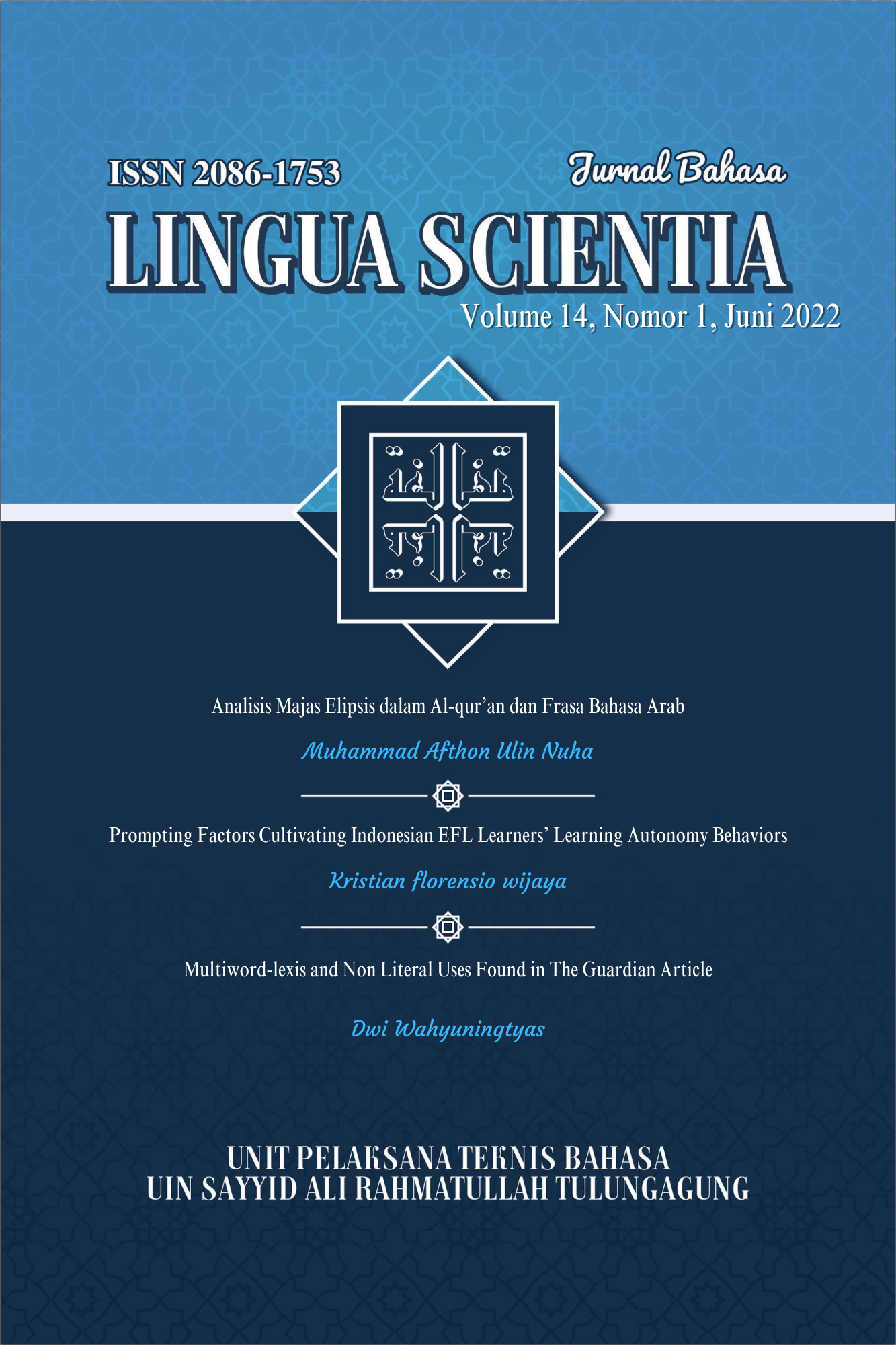THE EFFECTIVENESS OF USING ZOOM MEETINGS AND GOOGLE CLASSROOM ON LEARNING ENGLISH IN THE ERA OF THE COVID 19 PANDEMIC
Abstract
The goal of this study was to see how effective Zoom Meetings and Google Classroom are for English language learning in the wake of the Covid 19 pandemic. A survey method is used in the research design. The data for the study was collected using a questionnaire as a data collection tool. A random sample of 53 students was chosen by adjusting the conditions, and the research objective of learning English using Zoom was less effective, with many obstacles encountered, as evidenced by analysis of survey data from respondents, but students believe that learning using Google Classroom was more effective and simple. As a result, it can be concluded that using Google Classroom is more effective and preferred by students because it did not deplete the internet. Researchers also recommend that teachers use Google Classroom for online learning during a pandemic.
Downloads
References
Adedoyin, O B Soykan, E. (2020). Covid-19 pandemic and online learning: the challenges and opportunities. In Interactive Learning Environments. https://doi.org/10.1080/10494820.2020.1813180
Aristovnik, A. (2020). Impacts of the COVID-19 pandemic on life of higher education students: A global perspective. Sustainability (Switzerland), 12(20), 1–34. https://doi.org/10.3390/su12208438
Aristovnik, Aleksander, Keržič, D., Ravšelj, D., Tomaževič, N., & Umek, L. (2020). Impacts of the COVID-19 pandemic on life of higher education students: A global perspective. Sustainability (Switzerland), 12(20), 1–34. https://doi.org/10.3390/su12208438
Creswell, J. W. (2010). Research Design: Pendekatan Kualitatif, Kuantitatif, dan Mixed. Pustaka Pelajar: Yogyakarta.
Dornyei, Z., & Griffee, D. T. (2007). Research Methods in Applied Linguistics. Oxford University Press.
Haqien, D., Rahman, A. A., & Sejarah, P. (2020). Pemanfaatan Zoom Meeting Untuk Proses Pembelajaran Pada Masa Pandemi Covid-19. Jurnal SAP (Susunan Artikel Pendidikan) . Universitas IndraPrasta PGRI Jakarta, 5(1). https://doi.org/10.30998/sap.v5i1.6511
Ismawati, D., & Prasetyo, I. (2020). Efektivitas Pembelajaran Menggunakan Video Zoom Cloud Meeting pada Anak Usia Dini Era Pandemi Covid-19. Jurnal Obsesi : Jurnal Pendidikan Anak Usia Dini, 5(1), 665. https://doi.org/10.31004/obsesi.v5i1.671
Mayasari, F., Dwita, D., Jupendri, J., Jayus, J., Nazhifah, N., Hanafi, K., & Putra, N. M. (2019). Pelatihan Komunikasi Efektif Media Pembelajaran Google Classroom Bagi Guru Man 2 Model Pekanbaru. Jurnal Pengabdian UntukMu NegeRI, 3(1), 18–23. https://doi.org/10.37859/jpumri.v3i1.1155
Narayana, I. W. G. (2016). Analisis Terhadap Hasil Penggunaan Metode Pembelajaran Synchronous Dan Asynchronous. Seminar Nasional Teknologi Informasi Dan Multimedia 2016 STMK AMIKOM Yogyakarta 6-7 Februari 2016, 6–7.
Novantara, P. (2018). Implementasi E-Learning Berbasis Virtual Class Dengan Menggunakan Metode Synchronous Learning Pada Pembelajaran Di Universitas Kuningan. Buffer Informatika, 4(1), 1–7. https://doi.org/10.25134/buffer.v4i1.1290
Pakpahan, R., & Fitriani, Y. (2020). Analisa pemanfaatan teknologi informasi dalam pembelajaran jarak jauh di tengah pandemi virus corona covid-19. Journal of Information System,Applied, Management,Accounting and Research (JISAMAR), 4(2), 30–36.
Permata, A., & Bhakti, Y. B. (2020). Keefektifan Virtual Class dengan Google Classroom dalam Pembelajaran Fisika Dimasa Pandemi Covid-19. JIPFRI (Jurnal Inovasi Pendidikan Fisika Dan Riset Ilmiah), 4(1), 27–33. https://doi.org/10.30599/jipfri.v4i1.669
Singhal, T. (2020). A Review of Coronavirus Disease-2019 (COVID-19). In Indian Journal of Pediatrics (Vol. 87, Issue 4, pp. 281–286). https://doi.org/10.1007/s12098-020-03263-6
Smaldino, S. E., Lowther, D. L., & Russel, J. D. (2008). Instructional Technology and Media for Learning (Ninth Edition). NJ: Pearson Education inc.
Sugiyono. (2013). Metodelogi Penelitian Kuantitatif, Kualitatif Dan R&D. Bandung:Alfabeta.
Suharjito, S., & Halim, M. (2015). Learning Management System Development With Application of Asynchronous Learning Method in STMIK IBBI Medan. CommIT (Communication and Information Technology) Journal, 9(2), 83. https://doi.org/10.21512/commit.v9i2.936
Sukmawati, S., & Nensia, N. (2019). The Role of Google Classroom in ELT. International Journal for Educational and Vocational Studies, 1(2), 142–145. https://doi.org/10.29103/ijevs.v1i2.1526
Windhiyana, E. (2020). Dampak Covid-19 Terhadap Kegiatan Pembelajaran Online Di Perguruan Tinggi Kristen Di Indonesia. Perspektif Ilmu Pendidikan, 34(1), 1–8. https://doi.org/10.21009/pip.341.1
Yani Fitriani, Irfan Fauzi, M. Z. S. (2020). Motivasi Belajar Mahasiswa Pada Pembelajaran Daring Selama Pandemik Covid-19 Yani. Jurnal Kependidikan: Jurnal Hasil Penelitian Dan Kajian Kepustakaan Di Bidang Pendidikan, Pengajaran Dan Pembelajaran, 6(2), 165–175.
Zu, Z. Y. (2020). Coronavirus Disease 2019 (COVID-19): A Perspective from China. In Radiology (Vol. 296, Issue 2). https://doi.org/10.1148/radiol.2020200490
Copyright (c) 2022 Suryadi suryadi

This work is licensed under a Creative Commons Attribution-NonCommercial 4.0 International License.
Before going to review process, all manuscripts will be checked that they are free from plagiarism practice using "Turnitin" software. If there is an indication of plagiarism, the manuscript will instantly be rejected.


